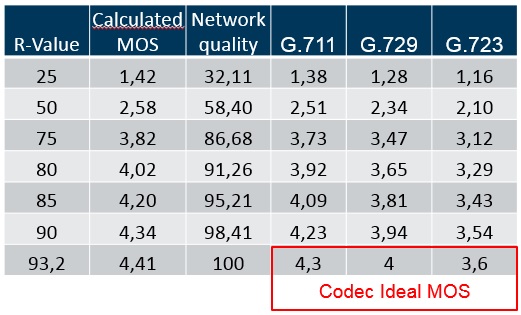MOS
(Added links) |
Marc St-Onge (Talk | contribs) (Corrected some spelling and sentence structure.) |
||
| Line 1: | Line 1: | ||
| − | Mean Opinion Score, more commonly known as MOS, is a voice call quality metric | + | Mean Opinion Score, more commonly known as MOS, is a voice call quality metric that ranges from 5 (excellent) to 1 (bad). It is a subjective method of quality assessment. |
== TelcoBridges and MOS == | == TelcoBridges and MOS == | ||
| − | [[Toolpack]] uses a well known model to evaluate a MOS value based on | + | [[Toolpack]] uses a well-known model to evaluate a MOS value based on collected statistics for a call. There are 3 factors that significantly impact the call quality: latency, packet loss and jitter of RTP packets. Using these statistics, we calculate an R-value that ranges from 1 to 100 where a higher number is better. Finally the MOS is calculated using this formula. |
| Line 11: | Line 11: | ||
=== TelcoBridges' MOS Implementation === | === TelcoBridges' MOS Implementation === | ||
| − | + | For the MOS calculated from the R-value, there is no notion of codec. We decided to apply a ratio in relation to the codec's ideal MOS. | |
| − | + | See the table below: | |
| Line 19: | Line 19: | ||
==== Network quality ==== | ==== Network quality ==== | ||
| − | TelcoBridges' MOS implementation adds | + | TelcoBridges' MOS implementation adds another concept over the standard MOS: Network quality. The network quality parameter provides a fast way to identify a bad network condition. The MOS is useful when comparing calls for the same [[NAP]] or for the same network. But if you are using several codecs, the MOS value might be misleading to detect network problems. |
*'''Examples:''' | *'''Examples:''' | ||
| − | **A perfect network (no packet loss, no latency) using G.723 will have a MOS of 3.6. This represents a network quality of 100%. The only way to improve the | + | **A perfect network (i.e. no packet loss, no latency) using G.723 will have a MOS of 3.6. This is relatively low, but it represents a network quality of 100%. The only way to improve the MOS will be to use a higher quality codec. |
| − | ** | + | **On the other hand, a G.711 call with a MOS of 3.7 represents a network quality of 86%. This rather low and based on these values, you know there is something that can be improved in the network. |
==== Ingress-Egress ==== | ==== Ingress-Egress ==== | ||
| − | There | + | There are 2 MOS values calculated per call leg. The ingress value is using RTP reception statistics and the egress value is using RTCP statistics received from the peer. Using these statistics, w can calculate MOS and network quality for the ingress and egress directions. |
| − | When using [[Call_Trace|Call Trace]] the lowest value between | + | When using [[Call_Trace|Call Trace]], the lowest value between ingress and egress MOS and network quality are displayed. |
[[Category:Glossary]] | [[Category:Glossary]] | ||
Latest revision as of 09:16, 26 July 2018
Mean Opinion Score, more commonly known as MOS, is a voice call quality metric that ranges from 5 (excellent) to 1 (bad). It is a subjective method of quality assessment.
Contents |
TelcoBridges and MOS
Toolpack uses a well-known model to evaluate a MOS value based on collected statistics for a call. There are 3 factors that significantly impact the call quality: latency, packet loss and jitter of RTP packets. Using these statistics, we calculate an R-value that ranges from 1 to 100 where a higher number is better. Finally the MOS is calculated using this formula.
MOS = 1 + 0.035R + ((R - 60) * (100 – R) * 0.000007R)
TelcoBridges' MOS Implementation
For the MOS calculated from the R-value, there is no notion of codec. We decided to apply a ratio in relation to the codec's ideal MOS.
See the table below:
Network quality
TelcoBridges' MOS implementation adds another concept over the standard MOS: Network quality. The network quality parameter provides a fast way to identify a bad network condition. The MOS is useful when comparing calls for the same NAP or for the same network. But if you are using several codecs, the MOS value might be misleading to detect network problems.
- Examples:
- A perfect network (i.e. no packet loss, no latency) using G.723 will have a MOS of 3.6. This is relatively low, but it represents a network quality of 100%. The only way to improve the MOS will be to use a higher quality codec.
- On the other hand, a G.711 call with a MOS of 3.7 represents a network quality of 86%. This rather low and based on these values, you know there is something that can be improved in the network.
Ingress-Egress
There are 2 MOS values calculated per call leg. The ingress value is using RTP reception statistics and the egress value is using RTCP statistics received from the peer. Using these statistics, w can calculate MOS and network quality for the ingress and egress directions.
When using Call Trace, the lowest value between ingress and egress MOS and network quality are displayed.
